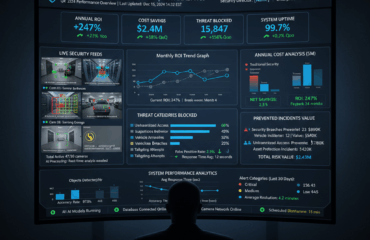
How smart security cameras are transforming enterprise risk management while delivering measurable ROI
Modern enterprises face an unprecedented challenge: securing increasingly complex facilities while managing tighter budgets and regulatory compliance requirements. Traditional CCTV systems that once seemed adequate now struggle to meet the demands of today’s security landscape. Enter AI security cameras – a transformative technology that’s reshaping how Security Directors and Facilities Managers approach enterprise protection.
This comprehensive guide cuts through the marketing noise to deliver practical insights you need to evaluate, justify, and implement AI video surveillance systems that deliver real business value.
What Are AI Security Cameras?
AI security cameras represent the next evolution in enterprise security systems, combining traditional video capture with advanced artificial intelligence capabilities. Unlike conventional CCTV that simply records footage for later review, smart security cameras analyze video streams in real-time, identifying threats, anomalies, and actionable insights as they occur.
At their core, these systems leverage computer vision, machine learning algorithms, and edge computing to transform passive surveillance into proactive security intelligence. They can distinguish between a delivery truck and a potential security threat, recognize when an employee enters a restricted area after hours, or detect unusual behavioral patterns that might indicate safety risks.
Key Technical Components:
- Edge AI Processing: On-device analysis reducing latency and bandwidth requirements
- Computer Vision: Real-time object recognition and behavioral analysis
- Machine Learning Models: Continuously improving threat detection accuracy
- Integration APIs: Seamless connection with existing security infrastructure
- Cloud Analytics: Centralized intelligence and reporting across multiple locations
For enterprise decision-makers, this translates to a fundamental shift from reactive security management to proactive risk mitigation – a transformation that directly impacts operational efficiency, liability exposure, and bottom-line results.
AI Security Cameras vs Traditional CCTV Systems
The gap between AI-powered and traditional surveillance systems isn’t just technological – it’s operational and financial. Understanding these differences is crucial for CISOs and Security Directors evaluating upgrade investments.
Detection Capabilities:
Traditional CCTV systems rely entirely on human operators to identify threats, typically discovering incidents only after they’ve occurred. Studies show security personnel monitoring multiple screens maintain peak attention for just 12-20 minutes before effectiveness drops significantly. AI security cameras eliminate this human limitation, providing 24/7 consistent monitoring with detection accuracy rates exceeding 97% for properly configured systems.
Response Time:
Conventional systems average 6-8 minutes for threat identification and response initiation. AI video surveillance systems can identify and alert security personnel within 15-30 seconds, reducing critical response time by up to 90%. For enterprises where every minute counts – whether preventing theft, ensuring employee safety, or maintaining compliance – this improvement delivers measurable value.
Operational Efficiency:
Traditional systems require an estimated 1 security operator per 8-12 camera feeds for effective monitoring. Smart security cameras can analyze hundreds of feeds simultaneously with a single operator overseeing the entire system. This efficiency gain typically translates to 40-60% reduction in security personnel costs while improving coverage quality.
Data Value:
Perhaps the most significant difference lies in data utilization. Traditional CCTV generates terabytes of stored footage with limited searchability or analytical value. AI security cameras produce structured data and actionable insights – occupancy patterns, safety compliance metrics, operational efficiency indicators – that extend far beyond security applications.
Key AI Features Every Security Director Should Know
Modern AI security cameras offer a sophisticated feature set that directly addresses enterprise security challenges. Understanding these capabilities ensures you select systems that align with your specific operational requirements.
Real-Time Threat Detection:
Advanced algorithms identify weapons, unauthorized access attempts, aggressive behavior, and other security concerns within seconds. Enterprise-grade systems achieve 97%+ accuracy rates with false positive rates below 2% when properly calibrated. This precision is critical for maintaining security team credibility and ensuring appropriate response allocation.
Behavioral Analytics:
Beyond simple object detection, AI systems analyze behavioral patterns to identify anomalies. They can detect loitering in restricted areas, unusual crowd gatherings, or employees exhibiting signs of distress. For facilities managers, this extends to safety applications – identifying workers not wearing required PPE or detecting slip-and-fall incidents in real-time.
Perimeter Security:
Intelligent perimeter monitoring distinguishes between authorized personnel, delivery vehicles, wildlife, and genuine security threats. Advanced systems integrate with access control databases to verify authorized presence and automatically adjust security postures based on schedules and personnel assignments.
License Plate Recognition:
Enterprise-grade ALPR systems maintain accuracy rates above 98% in various lighting and weather conditions. Integration with visitor management systems and employee databases enables automated vehicle tracking, parking enforcement, and enhanced visitor experience while maintaining security protocols.
Facial Recognition & Access Control:
Using facial recognition for identity verification, enables frictionless access control and visitor management. Enterprise systems can easily maintain detailed audit trails for compliance requirements as needed.
Integration Capabilities:
Modern AI security cameras function as components within broader security ecosystems utilizing APIs. They integrate with access control systems, fire safety equipment, building management systems, and emergency notification platforms to provide comprehensive facility protection and operational intelligence.
ROI Calculator: Justifying AI Security Investment
Security Directors face increasing pressure to demonstrate measurable returns on technology investments. AI security cameras deliver ROI through multiple channels that extend beyond traditional security metrics.
Direct Cost Savings:
Personnel Optimization:
- Reduced security staffing requirements: 40-60% decrease in monitoring personnel
- Improved guard efficiency through intelligent alerting and automated patrol routing
- Average annual savings: $120,000-180,000 for mid-size enterprise facilities
Incident Response Improvement:
- 85-90% reduction in response time translates to 60-70% decrease in incident severity
- Average incident cost reduction: $10,000-20,000 per major security event
- Insurance premium reductions: 5-10% annually with documented AI security deployment
Asset Protection:
- Theft reduction rates: 70-80% in properly monitored areas
- Vandalism prevention: 85-90% reduction in property damage incidents
Operational Efficiency Gains:
Space Utilization Optimization:
AI analytics provide detailed occupancy and usage patterns enabling:
- 10-15% improvement in space efficiency
- Reduced facility overhead through optimized cleaning, HVAC, and maintenance scheduling
- Annual operational savings: $25,000-50,000 per 100,000 sq ft facility
Compliance Documentation:
- Automated compliance reporting reduces administrative overhead by 60-70%
- Reduced audit preparation time and associated costs
- Decreased regulatory risk exposure and potential penalties
Risk Mitigation Value:
Liability Protection:
- Documented incident response and evidence collection
- Worker safety improvement leading to reduced workers’ compensation claims
- Reduces litigation risks and costs
Implementation Roadmap for Enterprise Facilities
Successful AI security camera deployment requires structured planning that addresses technical, operational, and organizational considerations. This roadmap provides a proven framework for enterprise implementations.
Phase 1: Assessment and Planning (6-8 weeks)
Security Audit and Needs Analysis:
Begin with comprehensive facility assessment identifying current vulnerabilities, coverage gaps, and operational pain points. Engage key stakeholders including Security Directors, Facilities Managers, IT leadership, and legal counsel to define requirements and success criteria.
Infrastructure Evaluation:
AI security cameras require robust network infrastructure supporting 10-25 Mbps per camera depending on resolution and analytics requirements. Assess current network capacity, power availability, and integration points with existing systems.
Compliance and Privacy Framework:
Establish clear policies addressing employee privacy, data retention, access controls, and regulatory compliance requirements. This foundation prevents deployment delays and ensures long-term operational sustainability.
Phase 2: Pilot Deployment (4-6 weeks)
Strategic Pilot Selection:
Deploy initial systems in high-value areas such as main entrances, parking facilities, or areas with existing security challenges. Pilot deployments should represent 10-15% of total planned coverage to validate performance and operational procedures.
Performance Baseline Establishment:
Document current incident rates, response times, and operational metrics to establish clear performance comparison baselines for ROI measurement.
Staff Training and Change Management:
Implement comprehensive training programs for security personnel, ensuring comfortable adoption of new capabilities while maintaining established security protocols.
Phase 3: Full Deployment (12-16 weeks)
Phased Installation Approach:
Deploy cameras in logical groupings based on operational priorities and facility characteristics. This approach minimizes disruption while enabling continuous system optimization based on real-world performance data.
Integration and Testing:
Complete integration with existing security infrastructure including access control, alarm systems, and emergency notification platforms. Conduct comprehensive testing ensuring seamless operation across all integrated systems.
Performance Optimization:
Fine-tune AI algorithms based on facility-specific patterns and requirements. This optimization phase typically requires 30-60 days to achieve optimal performance levels.
Phase 4: Optimization and Scaling (Ongoing)
Continuous Improvement:
Implement regular performance reviews and system optimization based on operational experience and evolving security requirements. Establish quarterly review cycles incorporating stakeholder feedback and performance metrics analysis.
Expanded Capabilities:
Evaluate opportunities for expanded AI applications including operational analytics, safety monitoring, and facilities optimization as system maturity and organizational comfort increase.
Vendor Selection: Critical Evaluation Criteria
Choosing the right AI security camera vendor significantly impacts long-term success and ROI realization. This evaluation framework helps Security Directors navigate vendor selection with confidence.
Technical Capability Assessment:
AI Performance Metrics:
Demand specific accuracy rates for detection scenarios relevant to your facility. Reputable vendors provide detailed performance documentation including false positive rates, detection accuracy across various conditions, and processing latency metrics. Insist on proof-of-concept testing in your actual environment before making final selections.
Integration Architecture:
Evaluate vendors’ integration capabilities with your existing security ecosystem. Systems should support standard protocols (ONVIF, RTSP) and provide robust APIs for custom integrations. Consider future expansion requirements and ensure selected vendors can support growing system complexity.
Scalability and Performance:
Assess vendors’ ability to support your growth requirements. Systems should handle increasing camera counts, expanding analytics requirements, and evolving integration needs without significant architectural changes.
Business Viability Evaluation:
Financial Stability:
AI security is a rapidly evolving market with numerous startup vendors offering innovative capabilities. Evaluate vendors’ financial stability, customer base maturity, and market position to ensure long-term support availability.
Customer References:
Require references from similar enterprise deployments including implementation timelines, performance achievement, and ongoing support quality. Direct customer discussions provide valuable insights unavailable through marketing materials.
Support and Service Capabilities:
Enterprise AI security systems require ongoing support for optimal performance. Evaluate vendors’ technical support structures, response time guarantees, and field service capabilities. Consider geographic coverage requirements for multi-location deployments.
Commercial Considerations:
Total Cost Structure:
Analyze complete cost structures including hardware, software licensing, installation, training, and ongoing support. Be particularly attentive to recurring costs that may impact long-term budget planning.
Contract Terms and Flexibility:
Review contract terms carefully, focusing on upgrade paths, performance guarantees, and termination provisions. Ensure contracts provide flexibility for changing requirements and technology evolution.
Implementation Support:
Project Management Capabilities:
Successful enterprise deployments require vendor project management support throughout implementation. Evaluate vendors’ implementation methodologies, project management resources, and change management support.
Training and Documentation:
Comprehensive training programs and detailed documentation are essential for successful adoption. Assess vendors’ training capabilities, documentation quality, and ongoing education support.
Making the Strategic Decision
AI security cameras represent a fundamental shift in enterprise security capabilities, offering unprecedented threat detection, operational efficiency, and business intelligence opportunities. For Security Directors and Facilities Managers ready to move beyond reactive security management, these systems provide a clear pathway to proactive risk mitigation and measurable ROI.
The key to success lies in strategic planning, careful vendor selection, and structured implementation that addresses both technical requirements and organizational change management. When properly deployed, AI video surveillance systems consistently deliver 200-300% ROI while significantly improving security posture and operational efficiency.
The question isn’t whether to implement AI security cameras, but how quickly you can deploy them effectively while maintaining operational continuity and achieving maximum value realization.
Ready to explore how AI security cameras can transform your enterprise security operations? The intelligent choice is to start with a comprehensive assessment of your current capabilities and requirements – the foundation for any successful technology transformation.



